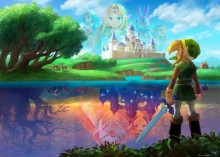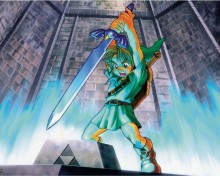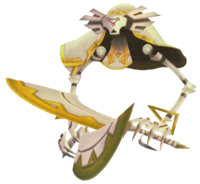The Best and Worst of Zelda: Dual Worlds
Posted on November 28 2013 by Brian Frost
 Hello readers! Brian here with the sixteenth edition of “The Best and Worst of Zelda.” This week’s theme has been specially chosen to coincide with the release of A Link Between Worlds just this past weekend. Don’t forget to comment your ideas for next week, but remember that the next few editorials will likely revolve around the newest entry to the series.
Hello readers! Brian here with the sixteenth edition of “The Best and Worst of Zelda.” This week’s theme has been specially chosen to coincide with the release of A Link Between Worlds just this past weekend. Don’t forget to comment your ideas for next week, but remember that the next few editorials will likely revolve around the newest entry to the series.
With the release of A Link Between Worlds, I was left thinking about the game’s theme of duality, and how it has been used throughout the series. It certainly isn’t the first theme that comes to one’s mind when Zelda is mentioned, but it is undeniably an important component of numerous games, and more specifically, their worlds. But how does this duality affect the continuity of gameplay, plot or pacing of the game? That’s exactly what we’ll be delving into today!
The first iteration of this feature is seen in A Link to the Past, which juxtaposes the kingdom of Hyrule and the Dark World. While the two are fundamentally different, the similarities between the worlds are what truly strike the player. The Dark World is quite similar in landscape to Hyrule, and while there are different dungeons, areas and towns to explore within it, the ability to switch between realms at any time allows for interesting Heart Piece locations and other things of the sort. But what I believe to be the most brilliant aspect of this new system is the character relation. Link will happen upon people in the overworld, homes, etc. who directly relate to characters in the Light World. In a recent issue of this editorial, I mentioned my adoration for the occurrence within the meadow of Flute Boy, wherein you meet a very odd character in that exact location, but instead in the Dark World. This interaction not only helps you to receive the necessary flute item, but leads to some very, very interesting results. For instance, the transformation of the Dark World version of Flute Boy into a tree, and a brilliant reaction from a relative of Flute Boy’s living in the village. This one sub-plot of A Link to the Past always strikes me as being one of the most intelligent uses of duality in the series. And let’s not forget that awesome Dark World music!
 Ocarina of Time is a spiritual successor to A Link to the Past, where it is obvious that the plan of attack by the developers was to emulate the things that made the Super Nintendo classic so brilliant, expand upon them, and then make them three-dimensional. Among these things was the system of dual worlds. Going between the past and present (or present and future?) creates a very intriguing way to see all of your favorite characters as they age over time. A great example of this is the young girl Malon at Lon Lon Ranch, who seems to be about Link’s age. Although it seems obvious that she would grow at the same rate as Link, It still caught me very much off guard the first time I saw her as an adult. Other moments such as the learning of Song of Storms, seeing Zelda in the future, and even seeing the grown form of Epona, who still recognizes her song, really amplify the experience. It’s a new sense of depth in the Zelda world, where characters are no longer so static. The time element is a brand new dimension for everything to move through, and it makes the game so much more enjoyable to see that.
Ocarina of Time is a spiritual successor to A Link to the Past, where it is obvious that the plan of attack by the developers was to emulate the things that made the Super Nintendo classic so brilliant, expand upon them, and then make them three-dimensional. Among these things was the system of dual worlds. Going between the past and present (or present and future?) creates a very intriguing way to see all of your favorite characters as they age over time. A great example of this is the young girl Malon at Lon Lon Ranch, who seems to be about Link’s age. Although it seems obvious that she would grow at the same rate as Link, It still caught me very much off guard the first time I saw her as an adult. Other moments such as the learning of Song of Storms, seeing Zelda in the future, and even seeing the grown form of Epona, who still recognizes her song, really amplify the experience. It’s a new sense of depth in the Zelda world, where characters are no longer so static. The time element is a brand new dimension for everything to move through, and it makes the game so much more enjoyable to see that.
 Two games which I would like to group together in the sense of dual worlds are Twilight Princess and Skyward Sword, which offer the Twilight Realm and the Spirit Realm respectively. While these worlds are not in any way like the ones in prior games (or A Link Between Worlds), they still deserve to be mentioned. Both the Spirit and Twilight Realm give the player a new task: collect a bunch of tears in a generally darker, less colorful of the area in which you were already. It’s tedious, to say the least. The first time I encountered this in Twilight Princess, I likened it to a depressing version of Banjo Kazooie, and let’s not forget that you had to play as Wolf Link, for whom I have already expressed my distaste many a time. And what bothered me even more about this was that I thought the concept of the Twilight to be quite intelligent. I liked experiencing the Twilight, but I hated having to preform the menial task of collecting tears. So why, WHY would they add the same puzzle structure to Skyward Sword? Well, actually, it wasn’t exactly the same. You played as a human, rather than a wolf, and I suppose that’s a real step up, but this was made up for by the frustration of having to run from the guards that lurked throughout the Silent Realm. Unlike with Twilight Princess, I didn’t find this design to be intelligent, nor slightly interesting, but all in all just a nuisance.
Two games which I would like to group together in the sense of dual worlds are Twilight Princess and Skyward Sword, which offer the Twilight Realm and the Spirit Realm respectively. While these worlds are not in any way like the ones in prior games (or A Link Between Worlds), they still deserve to be mentioned. Both the Spirit and Twilight Realm give the player a new task: collect a bunch of tears in a generally darker, less colorful of the area in which you were already. It’s tedious, to say the least. The first time I encountered this in Twilight Princess, I likened it to a depressing version of Banjo Kazooie, and let’s not forget that you had to play as Wolf Link, for whom I have already expressed my distaste many a time. And what bothered me even more about this was that I thought the concept of the Twilight to be quite intelligent. I liked experiencing the Twilight, but I hated having to preform the menial task of collecting tears. So why, WHY would they add the same puzzle structure to Skyward Sword? Well, actually, it wasn’t exactly the same. You played as a human, rather than a wolf, and I suppose that’s a real step up, but this was made up for by the frustration of having to run from the guards that lurked throughout the Silent Realm. Unlike with Twilight Princess, I didn’t find this design to be intelligent, nor slightly interesting, but all in all just a nuisance.
SPOILER ALERT! The rest of this article will focus heavily on A Link Between Worlds, and will cover the ending of the game! Turn back now if you wish to remain unspoiled!
It’s been almost a week since A Link Between Worlds was released, giving me time to 100% the game, and I can safely say that it is a fantastic game. It perfectly balances its similarities with its predecessor, A Link to the Past, while still adding plenty of new material to make it a unique game. But of all of the things that stand out as excellent in this game, the theme of duality between Hyrule and Lorule is one of the most prominent. I went into this game with the understanding that the overworld would be nearly identical to that of A Link to the Past in Hyrule, and that Lorule would be substantially different. I was at first disappointed to see that Lorule was not so different from the Dark World, It stopped mattering to me once I realized the pure genius of the system. Switching between worlds was definitely an interesting use of the painting mechanic, the similar characters in similar places were nice to see, but overall, it was the plot of it all that really got to me.
It becomes apparent almost immediately, when Link is introduced to Hilda, a raven-haired version of Zelda. It poses the question: what othercharacters have Lorule counterparts? And how does this relate to the dark Triforce in the cover art? This was what really intrigued me about Lorule, and it acted as most of my emotional motivation to progress through the game. My interests had been peaked. And I was more than impressed by the game’s elegant ending and denouement. A Lorule counterpart to Link had been your friend in Hyrule all game, and there was no hint to it, except for that pink bunny suit (awesome nod to A Link to the Past). The Triforce of Lorule was destroyed, and as it turns out, Hilda and Yuga happen o want Hyrule’s Triforce to save their world from destruction. Leaving Lorule in ruin with no way to rebuild their kingdom was a bittersweet moment, until of course you wish their Triforce back into existence. It’s a gorgeous moment, and a perfect ending to a beautiful game. Now I’d like to leave you with some epic music!
And that’s all we’ve got for this week. Due to release hype for A Link Between Worlds slowly decreasing, this weekly editorial can finally move back to it’s usual spot, every Tuesday at 11:00 AM US Central Time. Don’t forget to comment some ideas for the future, and as always, thanks for reading!



